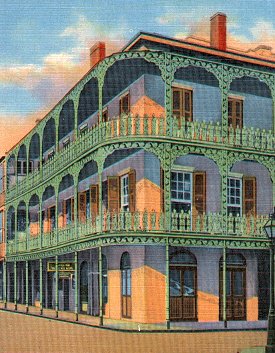French Quarter
|
|
UpperChartersNOLA.jpg
The French Quarter is the oldest and most famous section of the city of New Orleans, Louisiana, stretching along the Mississippi River from Iberville Street to Esplanade Avenue (12 blocks) and back from Decatur Street to Rampart Street (7 blocks). The area is also known as the Vieux Carré ("Old Quarter" in French) and the Barrio Latino ("Latin Section" in Spanish). To many it is simply called "The Quarter".
| Contents |
History
Most of the buildings date from before New Orleans became part of the USA, although there are some late 19th century and early 20th century buildings in the area as well. Since the 1920s the historic buildings have been protected by law and cannot be demolished, and any renovations or new construction in the neighborhood must be done according to regulations to match the period historic architectural style.
Despite the name, much of the architecture was built during the Spanish rule over New Orleans rather than the French. Elaborately decorated ironwork balconies and galleries from the 18th century and 19th centuries abound. (In south-east Louisiana, a distinction is made between balconies, which have no roof over them, and "galleries", which do.)
Long after the U.S. purchase of Louisiana, descendants of French colonists lived in this part of town, and the French language was often heard there as late as the start of the 20th century.
When the Americans began to move in after the Louisiana Purchase, they mostly built just upriver, across modern day Canal Street. The median of the wide boulevard became a place where the two contentious populations could meet and do business. As such, it became known as the "neutral ground", and this name persists in the New Orleans area for medians.
In the late 19th century the Old Quarter became a less fashionable part of town, and many immigrants from southern Italy settled in the section. In the early 20th century the Quarter's cheap rents and air of age and neglected decay attracted a bohemian and artistic community.
In the 1980s many long term Quarter residents were evicted or driven away by rising rents as property values rose dramatically with expectations of windfalls from the planned 1984 World's Fair nearby. More of the neighborhood became developed for the benefit of tourism. The French Quarter remains a combination of residential and commercial properties.
Jackson Square
Jackson Square (formerly Place des Armes) is a city-block sized open park, at the old center of the city. After the Battle of New Orleans it was named after victorious general Andrew Jackson, an equestrian statue of whom is in the center of the park.
To the front, the square originally overlooked the Mississippi across Decatur Street, but the view was blocked in the 19th century by the building of larger levees. The riverfront was long given to shipping, but the administration of Mayor Moon Landrieu put in a scenic boardwalk along the river across from the Square; it is known as the "Moon Walk" in his honor.
On the opposite side of the square are three 18th century historic buildings which were the city's heart in the colonial era. The center of the three is Saint Louis Cathedral. To its left is the Cabildo, the old city hall, now a museum, where the finalization of the Louisiana Purchase was signed. To the Cathedral's right is the Presbytere, built to match the Cabildo. The Presbytere originally housed the city's Roman Catholic priests and authorities, it was then turned into a courthouse at the start of the 19th century, and in the 20th century became a museum.
On the other two sides of the square are the Pontalba Buildings, matching red-brick block long 4 story buildings built in the 1840s. The ground floors house shops and restaurants; the upper floors are apartments that are the oldest continuously rented such apartments in North America.
Directly across from Jackson Square is the Jax Brewery building, the original home of a favorite local beer. After the company ceased to operate independently, the building was converted into several businesses, including restaurants and specialty shops.
From the 1920s through the 1980s the square was famous as a gathering place of painters of widely varying talents, including proficient professionals, talented young art students, hacks, and dreadful caricaturists. In the 1990s the artists were largely driven away by tarot card readers, mimes, and fortune tellers.
Live music is a regular feature of the square. Occasional formal concerts are held here, but for a century or more musicians playing for tips have set up in the square, the subject of unending controversy with nearby residents.
Diagonally across the square from the Cabildo is Café du Monde, open 24 hours a day, well known for the café au lait with chicory and beignets served there continuously since the 19th century.
Rue_Bourbon_street.jpg
Other French Quarter sights
Other well known sights in the French Quarter include the French Market; Bourbon Street (some eight blocks of the upper portion of this street are heavily given over to catering to young hard-drinking tourists); and Royal Street (with elegant antique shops and art galleries).
Surrounding neighborhoods
Up river from the Quarter is the city's Central Business District. Away from the river is the Treme neighborhood. Down river is the Faubourg Marigny.
Additional historic views of the French Quarter
- St. Peter Street, downtown side, looking towards Charters 51kb jpg
- Charters Street scene, c. 1900 48 kb jpg, lower Charters looking up towards Jackson Square, with the P.G.T. Beauregard house on the right
External links
- WikiTravel:New Orleans/French Quarter (http://wikitravel.org/en/article/New_Orleans/French_Quarter)
- FrenchQuarter.com: Your Essential Guide to New Orleans' Oldest Neighborhood (http://www.frenchquarter.com)

